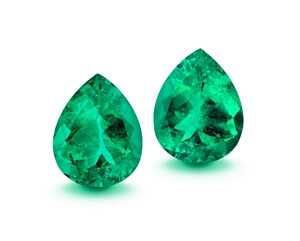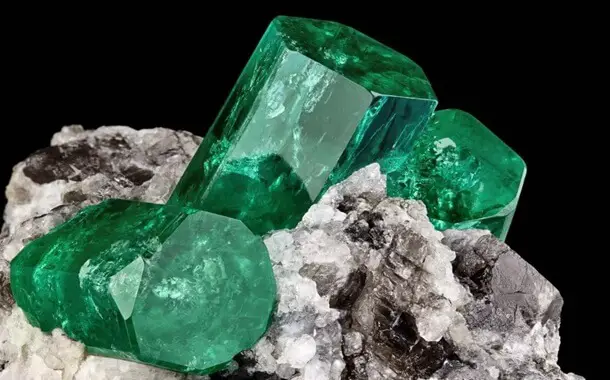How Much Do Emeralds Cost?
Last Updated on April 18, 2024
Written by CPA Alec Pow | Content Reviewed by ![]() CFA Alexander Popinker
CFA Alexander Popinker
Of all precious gemstones, emeralds have uniquely captivated humanity for centuries with their lush green hues and mystical allure. But given their prestige and cachet, how much do these rare treasures of nature actually cost?
As it turns out, emerald pricing spans an enormous range depending on the stone’s specific characteristics. A high-quality 1 carat emerald could cost anywhere from $500 to over $10,000. On the upper end, museum-quality investment grade emeralds over 5 carats can command prices exceeding $50,000 to $100,000 per carat at fine jewelry auctions.
This guide will examine the many nuanced factors that determine an emerald’s market value and price point. We’ll look at how color, clarity, cut, geographic origin, treatments, market supply and demand, and other variables affect the prices both jewelers and collectors will pay for this quintessential green gemstone. Let’s explore the complexities that set emerald prices.
How Much Do Emeralds Cost?
Unlike diamonds which are mined globally, natural emerald deposits are geologically confined to just a few rare locations in the world. As a general rule, Emeralds cost anywhere between $50 and $10,000 per carat. The specific source mine where the stone originated heavily influences its market value and price point:
- Colombian Emeralds – Since pre-Columbian times, Colombia’s renowned Muzo mines have supplied the world’s most prized emeralds revered for their vivid green colors, slight bluish undertones, and relatively high clarity compared to emeralds of other origins. Top-quality gems with proven Colombian provenance rival or even exceed the value of similarly sized top color and clarity diamonds, selling for upwards of $50,000 to over $100,000 per carat at fine auction when they very rarely appear. Even more commonly encountered commercial-grade Colombian emeralds with noticeable inclusions still start around $100 per carat due to the premium attached to Colombian sources.
- Zambian Emeralds – Discovered in the 1990s, Zambian emerald mines quickly established a reputation for producing stones with rich, deeper green coloration, typically with secondary yellowish-green rather than bluish undertones. The finest Zambian emeralds also display a high degree of clarity for the origin. Due to these desirable characteristics coupled with steady commercial-grade yield, Zambian emeralds market for anywhere from $50 per carat for smaller stones to over $10,000 a carat for investment-grade gems over one carat.
- Brazilian Emeralds – Stones mined from Brazil’s extensive emerald belts tend to display duller and paler green coloration with far more visible inclusions than their Colombian or Zambian counterparts. Because of these typically commercial-grade characteristics, Brazilian emeralds command lower market valuations starting under $50 per carat for jewelry-grade material. Much of Brazil’s production ends up in mass-market emerald fashion jewelry sold at retail. Fine collector specimens are exceptionally rare from Brazilian sources.
While individual cut, clarity, color, and carat fundamentals ultimately determine the price of any emerald, Colombian pedigree still commands the highest premiums when comparing stones of similar grade and characteristics from different geographic origins.
According to Emeralds.com, emeralds can range in price from less than $1 a carat to $100,000 a carat, depending on quality and characteristics.
James Allen Blog writes that the cost of an emerald can range from $200 to $900, depending on factors like cut, clarity, color, and carat weight. The quality of an emerald significantly influences its price, with cleaner, brighter, and greener emeralds being more expensive.
GemsPrice.com notes that the price of emeralds varies based on quality and size. For example, a one-carat emerald can sell for $525 to $1,125, while a five-carat emerald of the same quality can be sold for $7,500 to $15,000.
According to Gemstock.org, high-quality emeralds in the jewelry market can range from $6,000 to over $10,000 per carat.
Cut, Clarity, Color, and Carat Weight
Like diamonds, an emerald’s price depends heavily on how it rates across four primary quality characteristics known as the “4Cs”:
Cut – The skill with which the rough emerald crystal is cut, shaped, and faceted has a major impact on its optical properties and light performance. Finely proportioned cuts that maximize brilliance and fire garner significantly higher valuations. Commercial-grade stones tend to have unremarkable cuts.
Clarity – This refers to the internal purity and lack of identifiable inclusions in the gemstone when examined under 10x magnification. Flawless or near flawless emeralds free from distinguishing inclusions are the most coveted and valuable. Even minor eye-visible flaws can reduce emerald prices by half or more.
Color – Hue and saturation are the key color factors. Emeralds range from paler bluish-greens lacking intensity up to vivid rich greens with intense medium-dark tone. Vivid primary green emerald colors with secondary bluish undertones fetch premium valuations.
Carat Weight – Larger carat size translates directly to exponentially higher pricing, but even small fine emeralds still hold significant worth. Because of their fragility, large flawless emeralds over 5 carats are vastly more scarce than comparable diamonds.
It takes the perfect combination of superior cut, exceptional clarity, vibrant living color, and appreciable size for an emerald to achieve elite “AA” grading and prices over $10,000 per carat. Most fall into commercial grades below $500 per carat.
The Impact of Treatments on Price
The vast majority of natural emeralds on the market today have undergone some level of treatment, most commonly oils, resin or polymer infusions introduced into surface cavities and fractures to improve apparent clarity and color. When disclosed properly, these procedures have relatively minimal impact on an emerald’s value:
- Traditional Oiling/Resin Treatments – Standard oiling using cedar, peanut, or other natural oils, as well as clear epoxy-type resins to seal fissures, are universally accepted enhancements expected in the trade. As long as fully disclosed, emeralds subjected to these common procedures still command market prices approximating that of untreated stones. Buyers can expect to retain nearly full value when reselling ethically-treated gems.
- Undisclosed and Radical Treatments – Drastic or deceptive treatments like dyeing emeralds to alter their color constitute fraud. Radical alterations must always be detailed to buyers, as the price is significantly impacted once an emerald’s natural genesis is tampered with. Select sellers continue controversially treating emeralds without proper disclosure.
- Laboratory-Grown Synthetic Emeralds – Technological advances have enabled the production of emerald crystals in labs with identical chemical and optical properties to natural emeralds, at around 90% lower prices. While appealing for mass fashion jewelry, undisclosed synthetic selling as natural remains problematic. Reputable dealers openly reveal an emerald’s synthetic-created origins.
Consumers and professional buyers should exercise caution scrutinizing emerald sourcing and enhancement disclosures. Legitimate gemological labs can weed out fraud and affirm treatments. Upfront transparency ensures fair pricing.
You might also like our articles about the cost of garnet stones, amethyst stones, or obsidians.
Emerald Jewelry Market Factors
Like diamonds, rubies, sapphires, and other precious gemstones, emerald prices fluctuate over time based on global supply factors, consumer demand trends, and overall economic conditions. Some key market influences to watch include:
- Major New Mine Deposits – Whenever substantial new emerald reserves are discovered and developed, like when Zambian mines opened in the 1990s, prices typically dip as supply volumes increase before demand fully absorbs the new inventory. But established and validated source locales still retain their prestige.
- Extreme Rarity of Large Sizes – Due to fragility, emerald crystals over 5 carats are exponentially more scarce than comparable-sized diamonds. This growing rarity as carat size increases sustains the highest valuations for big flawless stones.
- Select Investment Grade Emeralds – The upper echelon of collector-grade Colombian emeralds over 5 carats having elite color and clarity grades are purchased as valuable portfolio assets that appreciate over decades as other tangible assets inflate. Recent auction records exceeded $3 million per carat.
- Mainstream Retail Jewelry Market Trends – While investment diamonds target the uber-wealthy, consumer desire for affordable emerald fashion jewelry still constitutes the mass retail market. But institutional collectors and savvy independents look beyond temporary trends.
For investors and collectors focused on enduring high-grade emeralds, while short-term fluctuations occur, natural precious emeralds have empirically demonstrated solid price growth over the long term as sources deplete and demand rises among increasingly affluent global consumers.
Buying Guidelines for Emerald Jewelry Shoppers
 For prospective consumers, these tips help guide emerald purchases at fair market values:
For prospective consumers, these tips help guide emerald purchases at fair market values:
- Seek respected lab report certifications from independent gemological authorities like GIA, AGL, or Gubelin to validate any claims of geographic origin, treatments, natural vs. synthetic genesis, and other relevant details for the stone in question.
- Only work with reputable, highly credentialed jewelers and gem dealers well-versed in industry standards who openly provide disclosure documentation. Be wary of big box chains lacking emerald expertise.
- Carefully review disclosures detailing any treatments, enhancements or synthesis origins before purchase. Radical undisclosed alterations negatively impact value.
- Judge cut quality by beauty, not technical precision. Optimal face-up proportions suit emeralds, not ideal measurements derived from diamonds.
- Set realistic budgets when sourcing loose emeralds or set jewelry. Expect to pay substantial premiums for clean emeralds above one carat due to their genuine scarcity.
- Confirm branded designer jewelry lines and legitimacy by looking for manufacturer codes engraved on mountings. Fakes abound.
While assessing emeralds involves nuance, gaining a deeper understanding of the many factors influencing prices allows buyers to navigate the market with confidence. Doing due diligence ensures satisfactory purchases on this most captivating of gemstones.
Final Words
In the gemstone world, emerald pricing spans an enormous range from just $50 per carat for commercial stones to over $100,000 per carat for investment-grade trophy jewels at fine auction. Location of origin, treatments, market supply dynamics, and most importantly quality based on the 4Cs of cut, clarity, color, and carat weight all interact to determine price levels.
While complex on the surface, methodically considering the unique characteristics of each individual emerald along with macro market conditions helps buyers make informed purchasing decisions. The allure of emeralds has persisted for millennia because of their breathtaking green tones symbolic of nature’s rebirth each spring. By understanding the nuances around valuing this rare gemstone, consumers gain confidence navigating the market to find attractively priced adornments that balance beauty, meaning and enduring worth.
Frequently Asked Questions
How rare are emerald gemstones compared to other precious gems?
Fine emeralds constitute well under 0.1% of the total global annual yield of colored gemstones. Large emeralds over 5 carats with few eye-clean inclusions are exponentially more scarce than comparable diamonds. Overall rarity exceeds all other major precious gems.
Which is rarer and more valuable, sapphire or emerald?
Overall, emeralds are more rare and command higher pricing than any sapphire variety. But exceptional “cornflower” blue Ceylon sapphires rival Colombian emeralds, with the most prized Kashmir sapphires valued as highly as top emeralds of similar size and purity.
What is the rarest and most expensive birthstone?
Of the primary modern birthstone gems, emeralds are by far the rarest and achieve the highest valuations, especially fine Colombian emeralds. Other renowned options like Alexandrite and Padparadscha sapphire also rank among the most precious and pricey birthstone choices.



Leave a Reply
Want to join the discussion?Feel free to contribute!